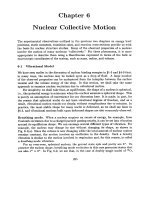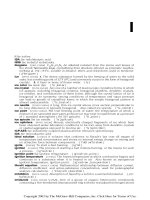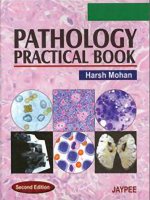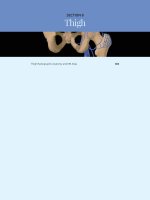Ebook Pediatric drug doses (2nd edition): Part 2
Bạn đang xem bản rút gọn của tài liệu. Xem và tải ngay bản đầy đủ của tài liệu tại đây (1 MB, 122 trang )
17
Antimyasthenics
CHAPTER
1. Edrophonium
Use: Diagnosis of myasthenia gravis.
Dosage: IV:
• Infants: Initial dose of 0.1 mg, if no response then followed
by 0.4 mg, total dose is 0.5 mg.
• Children: 0.04 mg/kg given over 1 minute, if no response
within 45 seconds then followed by 0.16 mg/kg (Max:
10 mg total).
Brands: 10 mg ampoule; Tensilon.
• May cause arrhythmias, hypotension, seizures,
drowsiness, laryngospasm, bronchospasm, diaphoresis.
Keep atropine ready for treatment of cholinergic crises
resulting from overdoses.
2. Neostigmine
Use: Treatment of myasthenia gravis, reversal of nondepolarizing neuromuscular blocking agents.
Dosage:
• Myasthenia gravis: Diagnosis: IM, 0.025-0.04 mg/kg as
a single dose. Treatment: IM, SC; 0.01-0.04 mg/kg q
2-4 hr and oral dose is 2 mg/kg/day q 3-4 hr (Max: 375
mg/day).
Antimyasthenics
113
• Reversal of nondepolarizing neuromuscular blockade:
0.025-0.1 mg/kg/dose (total dose: 5 mg). Use in conjunction with atropine or glycopyrrolate.
Brands: 15 mg Tab; Prostigmin, Tilstigmin. 0.5 mg Inj;
Myostigmin, Prostigmin.
• Does not antagonize succinylcholine. Use with caution
in patients of epilepsy, bradycardia, hypothyroidism,
asthma.
3. Pyridostigmine
Use: Treatment of myasthenia gravis, reversal of
neuromuscular blocking agents.
Dosage:
• Myasthenia gravis: In children 7 mg/kg/day in 5-6
divided doses.
• Reversal of nondepolarizing neuromuscular blockade:
0.1-0.25 mg/kg/dose preceded by atropine or
glycopyrrolate.
Brands: 30 and 60 mg Tab, Myestin.
• May cause seizures, headache, bradycardia, salivation,
miosis, urinary frequency.
18
Antiprotozoals
CHAPTER
1. Amphotericin-B
See under antifungal.
2. Chloroquine:
See under antimalarial.
3. Metronidazole
Use: Amoebiasis, giardiasis, trichomoniasis, SSTI, CNS infection, intra-abdominal infection, systemic anaerobic infections.
Dosage:
• Amoebiasis: PO: 35-50 mg/kg/day divided q 8 hr for 10
days.
• Other parasites: PO: 15-30 mg/kg/day divided q 8 hr.
• Anaerobic infection: PO, IV: 30 mg/kg/day divided
q 6 hr (Max: 4g/day).
Brands: 200 and 400 mg Tab; 200 mg/5 ml Susp; Aristogyl,
Flagyl, Metrogyl. 5 mg/ml Infusion; Flagyl, Metron.
Combinations: : Metronidazole + Diloxinate Furate; 400 + 500
mg Tab; 200 + 250 mg Susp; Entamizole. Metronidazole +
Furazolidone; 100 + 300 mg Tab; 75 + 250 mg Susp; Metrogyl-F.
Metronidazole + Furazolidone; 100 + 300 mg Tab; 25 + 75
mg Susp; Dependal-M.
• May cause metallic taste, nausea. Administer IV slowly
over 1/2-1 hr.
Antiprotozoals
115
4. Nitazoxanide
Use: Amoebiasis, giardiasis, helminth infections.
Dosage: PO; 1-4 yr: 100 mg BD; 4-10 yr: 200 mg BD; > 10 yr:
500 mg BD for 3 days.
Brands: 200 and 500 mg Tab; 100 mg/5 ml Syrup; Nitacure,
Nizonide, Nixide.
Combinations:
Nitazoxanide + Ofloxacin 500 + 200 mg Tab, 50 + 100 mg/
5 ml Syrup: Nitazet-O, Nizonide-O.
• Avoid in < 1 yr. May cause increase in SGPT and creatinine,
dizziness, discolored urine and pale yellow eyes.
5. Ornidazole
Use: Acute intestinal and extraintestinal amoebiasis,
giardiasis, anaerobic infections.
Dosage: PO: 40 mg/kg once a day; 3 days for amoebiasis
and 2 days for giardiasis.
Brands: 500 mg Tab; 125 mg/5 ml Susp; 5 mg/ml Infusion;
Dazolic, Ornida.
6. Pentamidine
Use: Visceral leishmaniasis, P. carinii pneumonia prevention
and treatment.
Dosage: IV, IM:
• P. carinii pneumonia treatment: 4 mg/kg/day OD for 14
days and for prophylaxis 4 mg/kg/dose q 2-4 wk.
• Leishmaniasis: 2-4 mg/kg/day OD for 15 days.
Brands: 300 mg Vial; Pentacarinate, Pentam.
116
Pediatric Drug Doses
• Vancomycin, Aminoglycoside and Amphotericin-B may
cause additive toxicity. Give IV slowly over a period of
1 hr in a concentration of 6 mg/ml.
7. Secnidazole
Use: Amoebiasis and giardiasis.
Dosage: 30 mg/kg single dose (Max: 2 gm).
Brands: 500 mg and 1 gm Tab; Ambiform, Etisec, Secnil,
Seczol.
8. Sodium Stibogluconate
Use: Leishmaniasis.
Dosage: IV, IM: 20 mg/kg/day for 20 days in LCL and DCL
and 28 days for ML and VL. Repeated courses may be
required in patients with severe cutaneous lesions, ML or
VL cases.
Brands: 100 mg Inj; Sodium Stibogluconate.
• May cause myalgias, arthralgias, abdominal discomfort,
elevated liver enzymes and hematologic changes.
9. Tinidazole
Use: Giardiasis and amoebiasis.
Dosage:
• Amoebiasis: 60 mg/kg/day single dose for 3 days.
• Giardiasis: 50 mg/kg single dose once.
Brands: 300 and 500 mg Tab; Fasigyn, Tini, Tiniba. 150 mg/
5 ml Susp; Tini.
• May cause metallic taste, dark urine, neuropathy, seizures,
leukopenia.
19
CHAPTER
Antipsychotics/
Anxiolytics/Sedatives
1. Chlordiazepoxide
Use: Anxiety, preanesthetic medication, behavioral disorders,
emotional disturbances.
Dosage: 0.3-0.5 mg/kg/day in divided doses.
Brands: 10 and 25 mg Tab; Dibrium, Librium.
• May cause drowsiness, dizziness, drug dependence.
2. Chlorpromazine
Use: Nausea and vomiting, mania, behavioral problems,
neonatal tetanus, to relieve restlessness and apprehension
prior to surgery.
Dosage: PO; IM, IV: 0.5-1mg/kg/dose q 6-8 hr. In neonatal
tetanus more frequent dosing can be used.
Brands: 25, 50 and 100 mg Tab; 25 mg/ml Inj; Megatil,
Chlorpromazine.
• May cause hypotension with IV use, tachycardia,
extrapyramidal reactions, rash, dry mouth, constipation.
3. Haloperidol
Use: Psychosis, severe behavioral problems, sedation,
choreiform movements.
118
Pediatric Drug Doses
Dosage:
• 3-12 yr: PO; Initial dose of 0.25-0.5 mg/day given in divided
doses, can be increased by 0.25-0.5 mg q week to maximum
of 0.15 mg/kg/day.
• 6-12 yr: IM: 1-3 mg/dose q 6-8 hr (Max: 0.15 mg/kg/day).
Brands: 0.25, 1.5 and 5 mg Tab; Depidol, Halidol, Serenace.
50 mg/ml Inj; Depidol-LA.
• May cause tachycardia, hypo- and hypertension,
sweating, extrapyramidal reactions, bronchospasm,
seizures, visual disturbances, leukopenia, anemia.
4. Thioridazine
Use: Psychotic disorders, depressive neurosis, behavioral
problems.
Dosage: PO; 0.5-3 mg/kg/day divided q 8 hr.
Brands: 10, 25 and 50 mg Tab; Delnil, Ridazin, Thioril.
• Use with caution in patients of cardiovascular problems
and seizures.
5. Triclofos
Use: Insomnia, as sedative in convulsions, recurrent colic.
Dosage: PO; 20 mg/kg/dose.
Brands: 500 mg/5 ml Syrup; Pedicloryl, Pedicalm.
• May cause rash, nausea, GI disturbances.
6. Trifluoperazine
Use: Hallucination, delusions, schizophrenia.
Dosage: PO in 6-12 years of age group. 1 mg/day in 2
divided doses can be increased gradually to required effect
(Max: 15 mg/day).
Antipsychotics/Anxiolytics/Sedatives
119
Brands: 1 and 5 mg Tab; Schizonil, Trinicalm. 5 and 10 mg
Tab; Neocalm, Trazine.
Combinations: Trifluoperazine + Isopropamide: 1 + 5 mg Tab;
Gastabid, Stelbid.
• May cause hypotension, arrhythmias, dystonias, constipation, dry mouth.
20
Antiretrovirals
CHAPTER
These agents are used for treatment of HIV infection.
NUCLEOSIDE/NUCLEOTIDE REVERSE
TRANSCRIPTASE INHIBITORS
Common side effects are nausea, vomiting, rash,
discoloration, fever, anorexia, diarrhea, headache, bone
marrow suppression; less common side effect are
hypersensitivity, lactic acidosis, hepatic steatosis,
pancreatitis, peripheral neuropathy, retinal depigmentation.
1. Abacavir
Dosage: PO: Children>3 mth and < 50 kg; 8 mg/kg q 12 hr.
Children > 50 kg; 20 mg/kg q 12 hr (Max: 300 mg/dose).
Brands: 300 mg Tab; Abamune, Abavir.
2. Didanosine
Dosage: PO: Children 2 wk to 8 mth: 50-100 mg/m2/day
divided q 12 hr. 8 mth to 13 yr: 120 mg/m2/day divided
q 12 hr. > 13 yr: 125 mg BD.
Brands: 25, 50 and 100 mg Tab; Dinex. 250 mg Cap; Dinex,
Virosine-DR.
• Food decreases bioavailability, antacids and gastric acid
antagonist may increase bioavailability.
Antiretrovirals
121
3. Lamivudine
Dosage: PO: Neonates < 30 days; 2 mg/kg/dose twice daily.
Infants and children: 4 mg/kg/dose twice daily (Max: 300
mg/day).
Brands: 150 and 300 mg Tab; Heptavir, Lamuvid. 50 mg/
5 ml Syp; Lamivir.
Combinations:
• Lamivudine + Stavudine: 150 + 30 and 150 + 40 Tab;
Lamistar.
• Lamivudine + Zidovudine: 150 + 300 mg Tab; Combivir.
Combination with Zidovudine prevent its resistance.
4. Stavudine
Dosage: PO: < 30 kg; 2 mg/kg/day divided q 12 hr.
30-60 kg; 30 mg twice daily.
Brands: 30 and 40 mg Tab; Virostav. 30 and 40 mg Cap;
Stag, Stavir.
• Combination with Zidovudine should not be used as it
antagonizes the effect.
5. Zidovudine
Dosage: PO:
• Prophylaxis: Premature infants; 4 mg/kg/day divided
q 12 hr. for up to 4 wk, then q 8 hr. Term neonates; 8 mg/
kg/day divided q 6 hr.
• Treatment: Children 6 wk to 12 yr; 480 mg/m2/day
divided q 8 hr. Adolescents; 200 mg thrice daily.
122
Pediatric Drug Doses
NON-NUCLEOSIDE REVERSE
TRANSCRIPTASE INHIBITORS
1. Efavirenz
Dosage: PO: Children > 3 yr; 10-15 kg: 200 mg; 15-20 kg:
250 mg; 20-25 kg: 300 mg; 25-32.5 kg: 350 mg; 32.5-40 kg:
400 mg; > 40 kg: 600 mg; given once daily.
Brands: 200 mg Tab; Viranz. 200 and 600 mg Cap; Efavir,
Efferven.
2. Nevirapine
Dosage: PO:
• Neonates: 240 mg/m2/day once daily for 14 days, then
same dose divided q 12 hr for next 14 days, followed by
400 mg/m2/day divided q 12 hr.
• Childrens: 4 mg/kg once daily for 14 days (Max: 400 mg/
day).
Brands: 200 mg Tab; Neve, Nevimune. 50 mg/5 ml Syp;
Nevimune.
• Should not be given with fatty foods.
Antiretrovirals
123
PROTEASE INHIBITORS
These agents may cause hyperglycemia, hyperlipidemia,
lipodystrophy, increases bleeding tendency, increase in liver
enzymes, bone marrow suppression, nephritis, nephrolithiasis, hepatitis, etc.
1. Amprenavir
Dosage: PO: Children 4-16 yr and wt < 50 kg; 22.5 mg/kg
BD.
2. Indinavir
Dosage: PO: 1500 mg/m2/day divided q 8 hr.
Brands: 400 mg Tab; Virodin. 400 mg Cap; Indivan, Indivir.
• Avoid fatty meals, drink plenty of fluid daily to resolve
drug induced renal colic due to nephrolithiasis.
3. Lopinavir
Dosage: PO: <40 kg; 40 mg/kg/day divided q 12 hr. > 40
kg; 800 mg/day divided q 12 hr.
Brands: Lopnavir + Ritonavir: 133.3 + 33.3 mg Cap;
Lupimune, Ritomax-L.
4. Nelfinavir
Dosage: PO (investigational):
• Neonates and Children < 2 yr: 30 mg/kg/day divided
q 8 hr.
• Children 2-13 yr: 60-100 mg/kg/day divided q 8 hr.
Administer with meal to optimize absorption.
Brands: 250 mg Tab; NEL, Nelfin.
124
Pediatric Drug Doses
5. Ritonavir
Dosage: PO: 400 mg/m2/day divided q 12 hr; titrate upward
in 50 mg/m2/dose increment to 800 mg/m2/day divided
q 12 hr.
Brands: 100 mg Cap; Ritomax, Ritomune.
• Adminster with food.
21
Antitubercular
CHAPTER
1. Cycloserine
Use: Adjunctive treatment in pulmonary and extrapulmonary TB.
Dosage: 10-20 mg/kg/day divided q 12 hr (Max dose: 1000
mg/day).
Brands: 250 mg Cap; Coxerin, Cyclorine, Myser.
• Contraindicated in epilepsy, depression, anxiety,
confusion. May increase daily requirement of vitamin
B12 and folic acid. Concomitant use of pyridoxine may
prevent neurotoxic effects.
2. Ethambutol
Use: M. tuberculosis and other mycobacterial diseases.
Dosage: 15-20 mg/kg/day once daily (Max: 1000 mg/day).
Brands: 200, 400 and 800 mg Tab; Albutol, Combutol,
Mycobutol, Themibutol.
• May cause optic and retrobulbar neuritis, hepatotoxicity.
Those children whose visual acuity can be determined
accurately should be given ethambutol.
3. Ethionamide
Use: M. tuberculosis and other mycobacterial diseases.
126
Pediatric Drug Doses
Dosage: 15-20 mg/kg/day once daily (Max: 1000 mg/day).
Brands: 250 mg Tab; Ethide, Ethomid, Myobit.
• May cause hepatotoxicity, peripheral neuropathy, tremor
and optic neuritis. If used along with cycloserine and
isoniazid may increase nervous system adverse effects.
Administer with pyridoxine to prevent neurotoxic effects.
4. Isoniazid
Use: M. tuberculosis.
Dosage: 5-10 mg/kg/day once daily (Max: 300 mg/day).
Brands: 100 and 300 mg Tab; Isonex, Solonex. 100 mg/5 ml
Susp; Siozide.
• May cause hepatitis, peripheral neuropathy, dizziness,
seizures. Administer 1 hr before or 2 hr after meals.
Advice patients to report prodromal symptoms of
hepatitis, tingling or numbness of extremities.
5. Para-aminosalicylic Acid
Use: M. tuberculosis.
Dosage: 200-300 mg/kg/day divided q 8 hr.
Brands: 1 gm Tab; Monospas.
• May cause hepatitis, hypokalemia, leukopenia and
goitrous hypothyroidism.
6. Pyrazinamide
Use: M. tuberculosis.
Dosage: 30-35 mg/kg/day once daily (Max: 1000 mg/day).
Brands: 500, 750 and 1000 mg Tab; Cavizide, Pyzina, PZACIBA. 250 mg/5 ml Syrup; PZA-CIBA.
• May cause arthralgia, hepatotoxicity, gout.
Antitubercular
127
7. Rifampicin
Use: M. tuberculosis; Meningococcal and H. influenzae
prophylaxis.
Dosage:
• Tuberculosis: 10 mg/kg/day empty stomach single dose.
• Meningococcal Prophylaxis: In neonates 10 mg/kg/day
divided q 12 hr; in infants and children 20 mg/kg/day
divided q 12 hr for 2 days.
• H. influenzae prophylaxis: In neonates 10 mg/kg/day
once daily and in infants and children 20 mg/kg/day
once daily for 4 days.
Brands: 150, 300 and 450 mg Cap; R-cin, Rimactane, Ticin.
100 mg/5 ml Susp; R-cin, Rimactane, Rimpin.
• May cause hepatotoxicity, gastritis, flu like illness. May
discolor urine, sweat, tears and other body fluid to red
orange color.
8. Amikacin, Clarithromycin, Kanamycin, Quinolones,
Streptomycin are also Used for Tuberculosis
For details see under respective section.
22
Antispasmodics
CHAPTER
1. Dicyclomine
Use: Functional disturbances of GI motility.
Dosage: PO; Infants > 6 mth, 5 mg/dose 3-4 times/day;
Children, 10 mg/dose 3-4 times/day. IM: 20 mg/dose.
Brands: 20 mg Tab; Coligon. 10 mg/ml Inj; Centwin,
Clomin.
Combinations:
Dicyclomine 20 mg + PCM 500 mg Tab; Spasmoflexon,
Spasmax.
Dicyclomine 20 mg + Diclofenac 50 mg Tab; Cataspa,
Onaspas.
Dicyclomine 10 mg + Dimethicone 40 mg: Per ml drop and
per 5 ml Susp; Colimex.
• Contraindicated in GI obstruction, tachycardia, urinary
tract obstruction and infant < 6 mth of age. Children of
Down's syndrome, spastic paralysis or brain damage are
more susceptible to adverse effects.
2. Drotaverine
Use: As spasmolytic in nephrolithiasis, cholelithiasis, spastic
constipation.
Antispasmodics
129
Dosage: 1-5 yr: 20 mg 3 times/day; 6-12 yr: 40 mg 3 times/
day.
Brands: 40 and 30 mg Tab; Dotarin, Drotin, Drot. 20 mg/
ml Inj; Drot, Tavan.
3. Hyoscine Butylbromide
Use: Spasmodic GI tract disorders, adjunctive therapy of
peptic ulcer, hypermotility of lower urinary tract, infant
colic.
Dosage: PO; Children > 6 yr, 10-20 mg, 3 times/day. Inj;
5 mg 3 times/day.
Brands: 10 mg Tab; 20 mg/ml Inj; 7.5 and 10 mg
Suppository; Buscopan.
• Contraindicated in megacolon, GI mechanical stenosis,
tachycardia.
4. Propantheline Bromide
Use: Adjunctive therapy of pancreatitis, ureteral and urinary
bladder spasm, peptic ulcer.
Dosage: 1-2 mg/kg/day in 3-4 divided doses.
Brands: 15 mg Tab; Probanthine, Spastheline.
23
Antitoxins
CHAPTER
1. Anti-snake Venom
Use: Snake bite along with required medical management.
Dosage: IV; Mild cases: 5 vials. Moderate cases: 5-15 vials.
Severe cases: 15-20 vials. Smaller children may require
higher dose due to large dose of venom injected per unit
body weight.
Brands: Available in lyophilized form and neutralizes
Cobra, Russel’s viper, Sawscaled viper and krait venom.
10 ml Polyvalent Inj; by BE, Bharat serum, Haffkine.
Administration: If time permits, do exclude equine serum
allergy by intradermal injection of 0.02 ml of 1:10 diluted
antivenom. The antivenom is given diluted in 250 ml of
normal saline at a rate of 20 ml/kg/hr.
2. Diphtheria Antitoxin/Antidiphtheric Serum (ADS)
Use: Diphtheria along with required medical management.
Dosage: Doses remain same in all age groups IV.
• Nasal diphtheria: 20,000 IU.
• Tonsillar and pharyngeal diphtheria: 40,000-80,000 IU.
• Laryngeal diphtheria: 120,000 IU.
• Severe disease of 3 days or more with neck swelling:
80,000-120,000 IU.
Antitoxins
131
Brands: Enzyme refined globulin solution 10,000 IU/vial
by Haffkine.
Administration: Test for hypersensitivity. Amount to be
given is diluted in 1:20 isotonic normal saline and given at
the rate of 1 ml/minute.
• Diphtheria immunoglobulin (DIG) can be used in place
of ADS in a dose of 0.6 ml/kg.
3. Gas Gangrene Antitoxin
Use: Gas gangrene infection caused by Clostridia bacteria.
Dosage: IV, IM, SC: 30,000-75,000 IU.
Brands: 10,000 IU/Vial; AGGS by Bharat serum.
4. Tetanus Antitoxin
Use: Prophylaxis and treatment of tetanus in cases where
tetanus immunoglobulin is not available.
Dosage: IM, SC:
• Prophylaxis, <30 kg: 1500 units. > 30 kg: 3000-5000 units
• Treatment; 50,000-100,000 units.
Brands: 750, 1500, 5000, 10000, 20000, 50000 IU Inj; by Bengal
immunity. 1500, 10000, 20000, IU Inj; by Haffkine.
Administration: Should be given after sensitivity test. For
treatment given half IV and half IM.
24
CHAPTER
Antiulcers/
Antisecretory
1. Proton Pump Inhibitor
These agents decrease gastric acid secretion by selectively
inhibiting the proton pump, also demonstrate activity
against H. pylori. These agents may cause constipation,
headache, abdominal pain, dizziness, rash, leukopenia.
Useful for duodenal ulcers, erosive gastritis, esophagitis,
hypersecretory conditions, prevention and treatment of
NSAIDs associated gastric ulcers, adjuvant therapy in the
treatment of H. pylori infection. Administer before eating.
Also available in combination with domperidone.
a. Lansoprazole
Dosage: PO; 0.5 mg/kg once daily in > 1 yr of age.
Brands: 15 and 30 mg Cap; Lan, Lanzap, Lanzol
• Decreases vitamin B12 absorption.
b. Omeprazole
Dosage: PO in > 2 yr of age; 0.6-0.7 mg/kg once daily. Titrate
to desired effect.
Brands: 10 and 20 mg Cap; Lomac, lomecid, Ocid.
c. Pantoprazole
Dosage: PO in > 6 yr of age; 0.5 mg/kg once daily.
Brands: 20 and 40 mg Tab; Lupipan, Pan, Pantocid.
Antiulcers/Antisecretory
133
2. Sucralfate
Use: Duodenal and gastric ulcer, prevention of stress ulcer,
NSAIDs associated mucosal damage, topically for
chemotherapy induced stomatitis, burns.
Dosage:
• PO; 40 - 80 mg/kg/day divided q 6 hr.
• Stomatitis: 5-10 ml of 1 gm/10 ml, Swish and spit or swish
and swallow 4 times/day.
Brands: 0.5 gm/5 ml; Sucral kid, Pepsigard-p. 1 gm/5 ml
Syrup; Pepsigard, Sucral. 1 gm Tab; Pepsigard, Sucral.
• Interferes with absorption of vitamin A, D, E and K may
cause constipation, dry mouth, hypophosphatemia,
vertigo, headache.
25
Antivirals
CHAPTER
1. Acyclovir
Use: Cutaneous herpes simplex, HSV encephalitis, HZV
infection, varicella zoster.
Dosage:
• Neonatal herpes: 20 mg/kg/dose q 8 hr IV for 14-21 day.
• HSV encephalitis: 10-20 mg/kg/dose q 8 hr IV for 14-21
day.
• Genital herpes: PO: 40-80 mg/kg/day divided q 8 hr for
5-7 day.
• Recurrent or suppression of genital herpes: 40-80 mg/
kg/day divided q 8 hr for 12 mth.
• Varicella zoster, initiate treatment within 24 hr of onset
of rash: PO: 20 mg/kg/dose, 4 times/day for 5 day.
Brands: 200, 400, 800 mg Tab; 25 mg/ml Inj; Acivir, Axovir.
• Incompatible with blood products and protein containing
solutions. Adequate hydration should be maintained
during therapy. Administer slowly to prevent renal
damage. Use with caution in liver disease and epilepsy.
Do not refrigerate solution because it can cause
precipitation of the drug.
2. Amantadine
Use: Prophylaxis and treatment of influenza-A virus
infection.
Antivirals
135
Dosage: PO: 5 mg/kg/day divided q 12 hr. Max 150 mg/
day in 1-9 yr and 200 mg/day in 10-20 yr of age group.
Brands: 100 mg Cap; Amantrel, Neaman.
• Administer within 24-48 hr of onset of symptoms and
duration of treatment is 2-5 day.
3. Cedofovir
Use: CMV retinitis; CMV, HSV, VZV infections resistant to
first line drug; recurrent respiratory papillomatosis.
Dosage: IV: For CMV retinitis: 5 mg/kg/dose once by slow
infusion.
• Oral probenecid must be accompanied before and after
IV cedofovir along with adequate NS hydration.
4. Famciclovir
Use: HSV and VZV infection.
Dosage: Can be used in older children in a dose of 200-500
mg/day for 5-7 day.
Brands: 250 and 500 mg Tab; Famtrex, Penvir, Virovir.
• May cause urinary retention, hypotension, electrolyte
imbalance.
5. Foscarnet
Use: Treatment of CMV, VZV infection resistant to first line
drug; CMV retinitis.
Dosage:
• CMV retinitis: Induction; 180 mg/kg/day divided q 8
hr for 14-21 day. Maintenance; 90-120 mg/kg/day once
daily.
• Resistant HSV: 40 mg/kg/dose q 8 hr for 3 wk.
136
Pediatric Drug Doses
6. Gancyclovir
Use: First choice drug for CMV infection, CMV retinitis,
also active against HSV-1 and 2.
Dosage: Slow IV infusion:
• Congenital CMV infection: 15 mg/kg/day BD.
• CMV retinitis: > 3 mth: Induction therapy; 10 mg/kg/
day twice a day for 14-21 day. Maintenance; 5 mg/kg/
day twice a day for 5 days in a week.
• Other CMV infection: Initial dose of 10-15 mg/kg/day
twice a day for 14-21 day followed by 5 mg/kg/day
single daily dose.
• Oral (following induction by IV) 30 mg/kg/dose q 8 hr
with food.
Brands: 250 and 500 mg Cap; Ganguard, Ganvir.
• Use with caution in patient with bone marrow
suppression. May cause pancreatitis, hematuria,
hypertension, electrolyte imbalance, neutropenia.
7. Idoxuridine
Use: Topical therapy for herpes simplex keratitis.
Dosage: Apply Oint 5 times/day and Solution 7-10 times/
day.
Brands: 0.1% Oint; Toxil. 0.1% drop; Idurin, Ridinox.
8. Interferon Alfa
Use and Dosage: SC:
• Hemangiomas of infancy: 1-3 million units/m2/day once
daily.
• Chronic hepatitis-B: 3-10 million units/m2/day, 3 times/
week.









